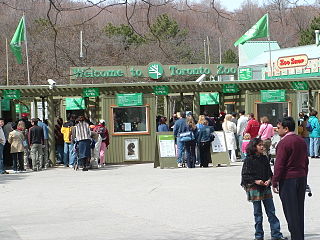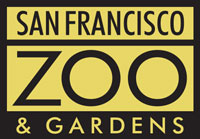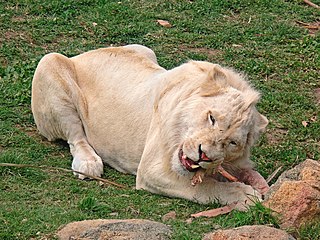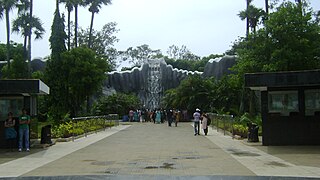
The Toronto Zoo is a zoo located in Toronto, Ontario, Canada. Encompassing 287 hectares, the Toronto Zoo is the largest zoo in Canada. It is divided into seven zoogeographic regions: Indo-Malaya, Africa, Americas, Tundra Trek, Australasia, Eurasia, and the Canadian Domain. Some animals are displayed indoors in pavilions and outdoors in what would be their naturalistic environments, with viewing at many levels. It also has areas such as the Kids Zoo, Waterside Theatre, and Splash Island. It has one of the most taxonomically diverse collection of animals on display of any zoo worldwide; it is currently home to over 5,000 animals representing over 500 species. The zoo is open to the public every day of the year except December 25.

Connecticut's Beardsley Zoo, located in Bridgeport, Connecticut, is the only Association of Zoos and Aquariums (AZA)-accredited zoo in the state of Connecticut. The zoo includes one of the few carousels in the state. The zoo has around 500 animals, from over 100 species, and welcomes about 280,000 visitors a year.
Tiger Temple, or Wat Pha Luang Ta Bua Yanasampanno , was a Theravada Buddhist temple in the Sai Yok District of Thailand's Kanchanaburi Province in the west of the country. It was founded in 1994 as a forest temple and sanctuary for wild animals, among them tigers, mostly Indochinese tigers. A "commercial" temple, Tiger Temple charged an admission fee.

The San Francisco Zoo is a 100-acre (40 ha) zoo located in the southwestern corner of San Francisco, California, between Lake Merced and the Pacific Ocean along the Great Highway. The SF Zoo is a public institution, managed by the non-profit San Francisco Zoological Society, a 501(c)(3) organization. under a public-private partnership since 1993, receives $4.2 million annually from the city. As of 2016, the zoo housed more than one thousand individual animals, representing more than 250 species. It is noted as the birthplace of Koko the gorilla, and, from 1974 to 2016, the home of Elly, the oldest black rhinoceros in North America.
The Born Free Foundation is an international wildlife charity that campaigns to "Keep Wildlife in the Wild". It protects wild animals in their natural habitat, campaigns against the keeping of wild animals in captivity and rescues wild animals in need. It also promotes compassionate conservation, which takes into account the welfare of individual animals in conservation initiatives. Born Free also creates and provides educational materials and activities that reflect the charity's values.

The Navajo Nation Zoological and Botanical Park is located in Window Rock, Arizona, the capital of the Navajo Nation. It is the only tribally owned zoological park in the United States and is notable among zoological facilities in that it labels its exhibits in the Native American Indian language of Navajo. Having been operated by the Navajo Nation Parks & Recreation Department since its inception in the early 1960s, it became part of the Navajo Nation Department of Fish and Wildlife in September 2006.

The white lion is a rare colour mutation of the lion, specifically the Southern African lion. White lions in the area of Timbavati are thought to have been indigenous to the Timbavati region of South Africa for centuries, although the earliest recorded sighting in this region was in 1938. White lions first became known to the English-speaking world in 1977 through the book The White Lions of Timbavati.

Nandankanan Zoological Park is a 437-hectare (1,080-acre) zoo and botanical garden in Bhubaneswar, Odisha, India. Established in 1960, it was opened to the public in 1979 and became the first zoo in India to join World Association of Zoos and Aquariums (WAZA) in 2009. It also contains a botanical garden and part of it has been declared a sanctuary. Nandankanan, literally meaning The Garden of Heaven, is located near the capital city, Bhubaneswar, in the environs of the Chandaka forest, and includes the 134-acre (54 ha) Kanjia lake.

The Wildheart Animal Sanctuary, previously known as the Isle of Wight Zoo and Sandown Zoo, is a wildlife sanctuary on the coastline of Sandown, Isle of Wight. At 8.5 acres, it is the largest collection of exotic animals on the Island.
Citizens Lobbying for Animals in Zoos (CLAZ) was an informal organization lobbying to improve conditions for the animals in California zoos, started in 1996 by then 13-year-old Justin Barker.
The Greater Wynnewood Exotic Animal Park, alternatively known as the G.W. Zoo, Tiger King Park and formerly the Garold Wayne Exotic Animal Memorial Park, was an animal park displaying predominantly tigers and other big cats in Wynnewood, Oklahoma, United States. The park garnered substantial public attention due to the 2020 Netflix documentary series Tiger King: Murder, Mayhem and Madness, which focused on park founder and owner Joe Exotic.

The Wild Animal Sanctuary is a 1,214-acre (491 ha) animal sanctuary in Keenesburg, Colorado, United States. The sanctuary specializes in rescuing and caring for large predators which are being ill-treated, for which their owners can no longer care, or which might otherwise be euthanized. It is a 501(c)(3) nonprofit organization and a state and federally licensed zoological facility.

The Lincoln Children's Zoo is a children's zoo located in Lincoln, Nebraska. Designed specifically for children to experience interactive, up-close encounters with all of the zoo's animals, Lincoln Children's Zoo has been accredited by the Association of Zoos and Aquariums (AZA).

The Yorkshire Wildlife Park is a zoo, wildlife conservation and rehabilition centre and tourist attraction located in Branton, south-east of Doncaster, South Yorkshire, England. It opened in 2009 on the site of Brockholes Farm, a former riding school and petting zoo, and features 500 animals of 100 species. Yorkshire Wildlife Park is an official member of the British and Irish Association of Zoos and Aquariums (BIAZA) and the European Association of Zoos and Aquaria (EAZA).

Arignar Anna Zoological Park, also known as the Vandalur Zoo, is a zoological garden located in Vandalur, to southwest of Chennai, Tamil Nadu, about 31 kilometres (19 mi) from the Chennai Central and 15 kilometres (9.3 mi) from Chennai Airport. Established in 1855, it is the second public zoo in India. It is affiliated with the Central Zoo Authority of India. Spread over an area of 602 hectares, including a 92.45-hectare (228.4-acre) rescue and rehabilitation centre. The zoo houses 2,553 species of flora and fauna across 1,265 acres (512 ha). As of 2012 the park houses around 1,500 wild species, including 46 endangered species, in its 160 enclosures. As of 2010, there were about 47 species of mammals, 63 species of birds, 31 species of reptiles, 5 species of amphibians, 28 species of fishes, and 10 species of insects in the park. The park, with an objective to be a repository of the state's fauna, is credited with being the second wildlife sanctuary in Tamil Nadu after Mudumalai National Park.

Big Cat Rescue Corp., also known as BCR and previously known as Wildlife on Easy Street, Inc., operates an animal sanctuary in Hillsborough County, Florida, United States, which rescues and houses exotic cats, and rehabilitates injured or orphaned native wild cats. It was founded by Don Lewis and Carole Baskin in 1995.
The Phnom Tamao Wildlife Rescue Centre is a wildlife centre located roughly 25 miles (40 km) by road south of Phnom Penh, Cambodia. The centre was established in 1995 and with an area of over 6,000 acres of protected regenerating forest, this is the largest zoo in Cambodia. Since 2001, PTWRC has been run by the government institution of Cambodian Forestry Administration in partnership with an environmental non-profit organization called Wildlife Alliance. Wildlife Alliance animal husbandry specialists, veterinarians, and care takers assist in the feeding and care of animals and operations. PTWRC currently houses over 1,200 rescued animals from 102 species including endangered Asian elephants, tigers, Pileated gibbon, Siamese crocodile, Malayan sun bears, among many others. Many of the species are listed as Endangered or Vulnerable by the International Union for Conservation of Nature (IUCN).

Four Paws is a global animal welfare organisation based in Vienna, Austria. It focuses on improving the living conditions of animals under direct human influence, by revealing suffering, rescuing animals in need, and protecting them.














